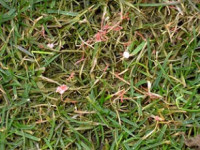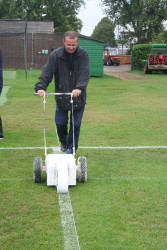August Football Diary
 The weather this month appears to be following much in the same vein as this time last year with frequent showers expected across most parts of the country. In the most part, this is welcome to those of us who are without the means to irrigate, it can be particularly useful when required to water fertiliser applications off the grass leaf and into the base of the plant, ensuring adequate moisture levels for the germination of newly sown grass seed and for promoting the healthy growth of newly sprouted grass seedlings.
The weather this month appears to be following much in the same vein as this time last year with frequent showers expected across most parts of the country. In the most part, this is welcome to those of us who are without the means to irrigate, it can be particularly useful when required to water fertiliser applications off the grass leaf and into the base of the plant, ensuring adequate moisture levels for the germination of newly sown grass seed and for promoting the healthy growth of newly sprouted grass seedlings.
It can be frustrating sometimes when, for the most part, it always seems to be raining when you arrive into work in the morning. At least, apart from the good opportunity it provides in catching up with paper work, it will also give an opportunity to ensure that the machinery is in top condition along with your workshop.
 Inevitably though, with the increase in soil moisture, and also like last year, there seems to be a rise in the incidence of red thread, which doesn't seem to be responding to applications of fertiliser. If it isn't bad and you can live with it then you should do so. But, if your infestations are bad to the extent that you are considering an application of fungicide, it is good practice to rotate the type of fungicide used. This will help in the long term by not encouraging resilient strains of red thread that would be difficult to control in future. To ensure that you are rotating fungicides correctly, look at the class or chemical family to ensure that you devise a good rotational plan. Don't confuse this with chemical type, which can be either systemic or contact for instance, or the mode of action, which is to do with how it affects the growth processes in the plant.
Inevitably though, with the increase in soil moisture, and also like last year, there seems to be a rise in the incidence of red thread, which doesn't seem to be responding to applications of fertiliser. If it isn't bad and you can live with it then you should do so. But, if your infestations are bad to the extent that you are considering an application of fungicide, it is good practice to rotate the type of fungicide used. This will help in the long term by not encouraging resilient strains of red thread that would be difficult to control in future. To ensure that you are rotating fungicides correctly, look at the class or chemical family to ensure that you devise a good rotational plan. Don't confuse this with chemical type, which can be either systemic or contact for instance, or the mode of action, which is to do with how it affects the growth processes in the plant.
Follow this link for a useful chart of turf grass chemical families that gives also the common names and trade names: Turf grass fungicides
Early This Month
Continue with your applications of wetting agents if you have embarked on a programme that includes them. This will have helped in the fight against dry patch and also helped better utilisation of your water resources. You may also consider an application of a seaweed based tonic, particularly if your grass has come under, or is, showing signs of stress as this will aid its recovery.
It's not too late to apply a selective weed killer if you are having trouble with weeds, though you will need to consider carefully the age of your grass, the weeds that you wish to control and match this to a product suitable for the task.
Pitch set ups
 Some of you will be on your final pitch preparations now including setting out and initial marking. Always best at this stage to double check your measurements before committing to a white line as this will show up badly if it is out and needs correcting. Check that your goal sockets are set in line with the base line and are not out and that when the post is in that they are upright. Correct this now to ensure a professional look, particularly with the newly painted goals posts and nets ready to be put into place.
Some of you will be on your final pitch preparations now including setting out and initial marking. Always best at this stage to double check your measurements before committing to a white line as this will show up badly if it is out and needs correcting. Check that your goal sockets are set in line with the base line and are not out and that when the post is in that they are upright. Correct this now to ensure a professional look, particularly with the newly painted goals posts and nets ready to be put into place.
Keep casual play out of goal mouth areas. This can be easily achieved if you have a set of portable goals that can be moved around to different parts of your field or pitch. However, if you have socket goals then your task may be a little more difficult.
Later This Month
A supplemental feed may be required to top up the nutrients as determined by your planned nutrient programme. Fixtures may start to come in now if you haven't already got them. It will be a good time to look through them picking up on any major or important fixtures that will require something special. In which case you can start thinking about any special treatments or work that will be required in the lead up, and pen an advance reminder in your diary.
Make sure you have enough line marking material to hand and enough to get you through your season. Inspect your marker and ensure that it is in good working order for when you need it.
Machinery at this time of year is probably not at the top of everyone's thoughts, but a short service now will go a long way to ensure reliability in the longer term. You may also pick up on any possible problems that will save on a costly down time and hamper you getting off to a good start to the season.
Ongoing maintenance
If you are unable to provide irrigation to the whole pitch then at least you should try and ensure adequate watering of the goalmouth and centre circle areas. If you follow a programme of using wetting agents to ensure a uniform wetting, this will help.
Drag matting and brushing: Continue the work of brushing to keep the air circulating around the base of the plant, particularly important for removing early morning dew and controlling disease.
Cutting: Continue cutting regularly at around 25 -37mm to ensure good sward density. It may sometimes be helpful with newly sown grasses to lightly roll the surface before cutting to ensure that the weakly held grasses in the surface do not get pulled out. Also ensure that any cutting equipment used is keenly set to cut without tearing.
Verticutting will help to ensure that the sward is kept clean of lateral growth that may be appearing and also help to ensure that good circulation of air around the base of the plant.
Spiking: Continue spiking when the conditions are right (this should only be carried out if the soil is suitably moist) to augment your deep spiking carried out to alleviate built up compaction. Keep your spiking regime flexible, alternating between surface spiking, deep spiking and slitting.
Marking out; take your time over this. Rushed lines invariably wander and create a false impression, lowering the overall standard and vision of an otherwise perfect surface. An accurate line makes such a difference.
By Malcolm Gardner
Grounds Manager
BA Clubs
